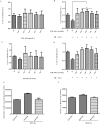Protective effects of new aryl sulfone derivatives against radiation-induced hematopoietic injury
- PMID: 32173735
- PMCID: PMC7299261
- DOI: 10.1093/jrr/rraa009
Protective effects of new aryl sulfone derivatives against radiation-induced hematopoietic injury
Abstract
The hematopoietic system is sensitive to radiation. In this research, new aryl sulfone derivatives (XH-201 and XH-202) containing a nitrogen heterocycle were designed and synthesized and their radio-protective efficacies with regard to the hematopoietic system were evaluated. XH-201 administration significantly increased the survival rate of mice after 8.0 Gy total body irradiation (TBI). The results showed that XH-201 treatment not only increased the white blood cells, platelets counts and the percentage of hematopoietic progenitor cells and hematopoietic stem cells in mice exposed to 4.0 Gy TBI but also decreased DNA damage, as determined by flow cytometric analysis of histone H2AX phosphorylation. In addition, our data demonstrated that XH-201 decreased the mitochondrial reactive oxygen species (ROS) levels in hematopoietic cells. Overall, these data suggest that XH-201 is beneficial for the protection of the hemoatopoietic system against radiation-induced injuries.
Keywords: aryl sulfone derivatives; hematopoietic cells; radioprotection.
© The Author(s) 2020. Published by Oxford University Press on behalf of The Japanese Radiation Research Society and Japanese Society for Radiation Oncology.
Figures







Similar articles
-
Protection of the hematopoietic system against radiation-induced damage: drugs, mechanisms, and developments.Arch Pharm Res. 2022 Aug;45(8):558-571. doi: 10.1007/s12272-022-01400-7. Epub 2022 Aug 11. Arch Pharm Res. 2022. PMID: 35951164 Review.
-
The protective effects of XH-105 against radiation-induced intestinal injury.J Cell Mol Med. 2019 Mar;23(3):2238-2247. doi: 10.1111/jcmm.14159. Epub 2019 Jan 20. J Cell Mol Med. 2019. PMID: 30663222 Free PMC article.
-
The Protective Effects of 5-Methoxytryptamine-α-lipoic Acid on Ionizing Radiation-Induced Hematopoietic Injury.Int J Mol Sci. 2016 Jun 14;17(6):935. doi: 10.3390/ijms17060935. Int J Mol Sci. 2016. PMID: 27314327 Free PMC article.
-
3,3'-diindolylmethane mitigates total body irradiation-induced hematopoietic injury in mice.Free Radic Biol Med. 2016 Oct;99:463-471. doi: 10.1016/j.freeradbiomed.2016.09.007. Epub 2016 Sep 5. Free Radic Biol Med. 2016. PMID: 27609226
-
C/EBPδ deficiency sensitizes mice to ionizing radiation-induced hematopoietic and intestinal injury.PLoS One. 2014 Apr 18;9(4):e94967. doi: 10.1371/journal.pone.0094967. eCollection 2014. PLoS One. 2014. PMID: 24747529 Free PMC article.
Cited by
-
Exosomes are involved in total body irradiation-induced intestinal injury in mice.Acta Pharmacol Sin. 2021 Jul;42(7):1111-1123. doi: 10.1038/s41401-021-00615-6. Epub 2021 Feb 26. Acta Pharmacol Sin. 2021. PMID: 33637947 Free PMC article.
-
Protection of the hematopoietic system against radiation-induced damage: drugs, mechanisms, and developments.Arch Pharm Res. 2022 Aug;45(8):558-571. doi: 10.1007/s12272-022-01400-7. Epub 2022 Aug 11. Arch Pharm Res. 2022. PMID: 35951164 Review.
References
-
- Kamran MZ, Ranjan AN, Kaur S et al. . Radioprotective agents: Strategies and translational advances. Med Res Rev 2016;36:461–93. - PubMed
-
- Johnke RM, Sattler JA, Allison RR. Radioprotective agents for radiation therapy: Future trends. Future Oncol 2014;10:2345–57. - PubMed
-
- Patyar RR, Patyar S. Role of drugs in the prevention and amelioration of radiation induced toxic effects. Eur J Pharmacol 2018;819:207–16. - PubMed
MeSH terms
Substances
LinkOut - more resources
Full Text Sources
Medical

